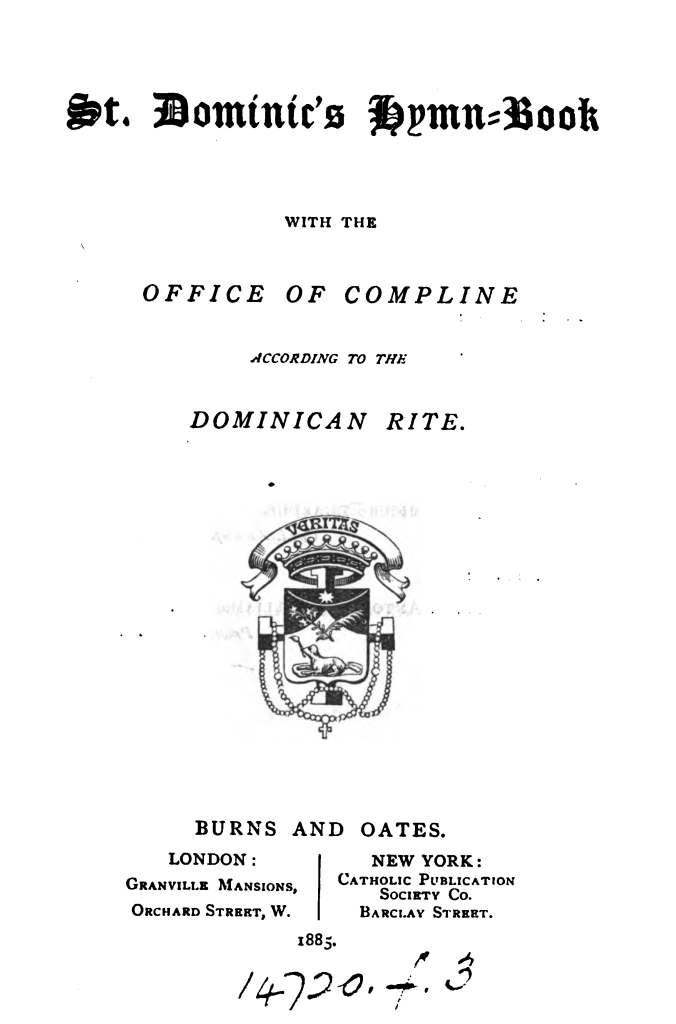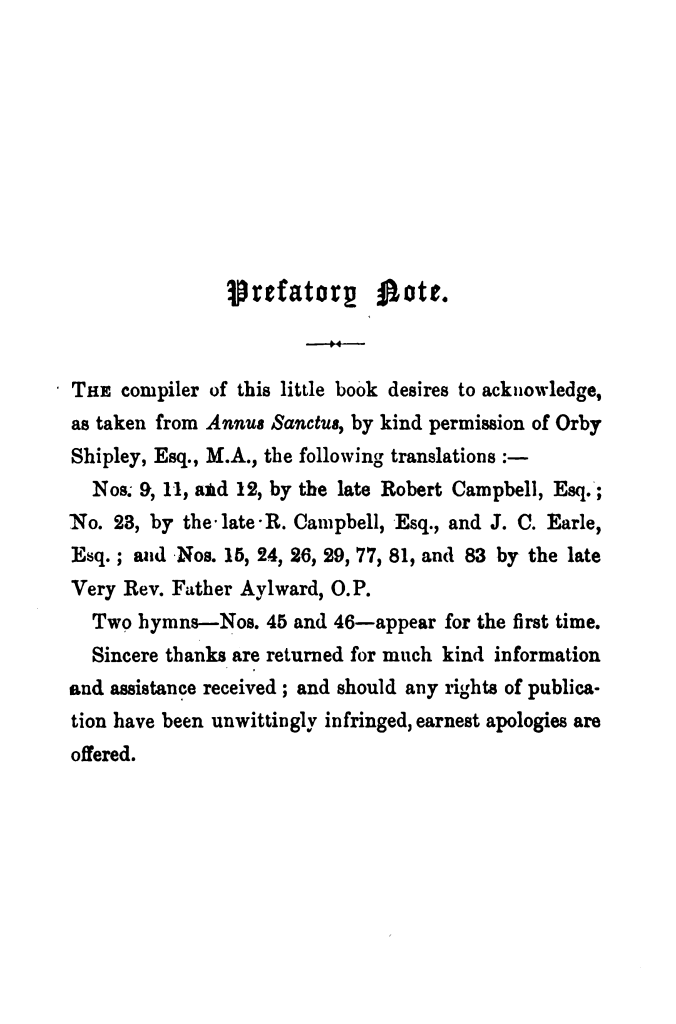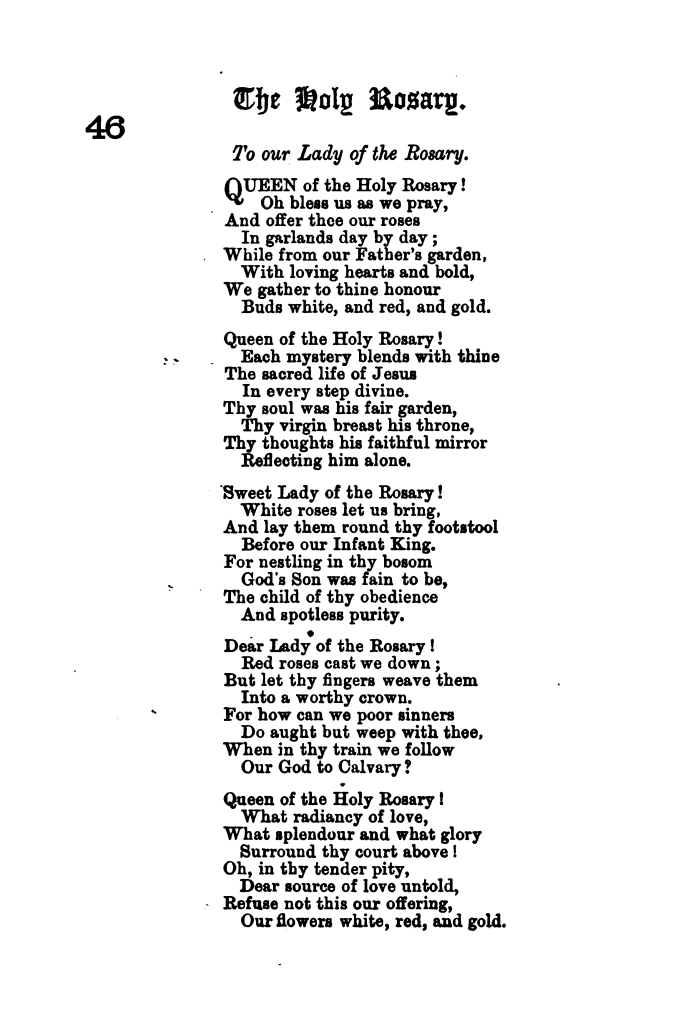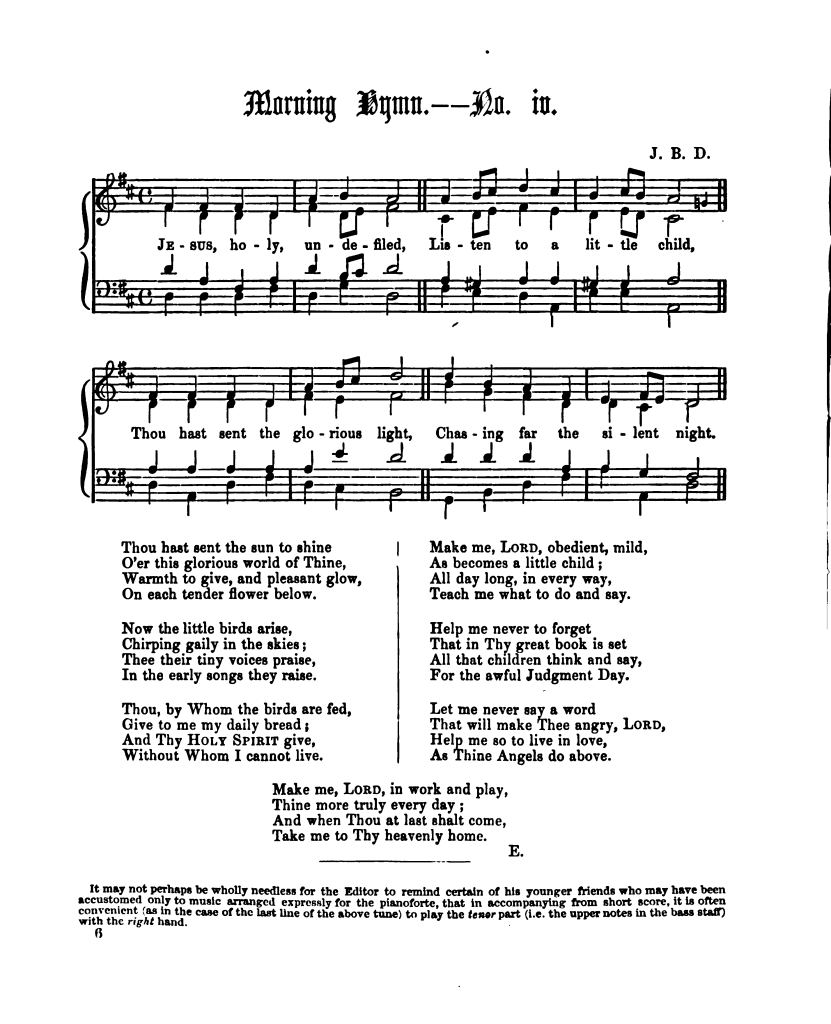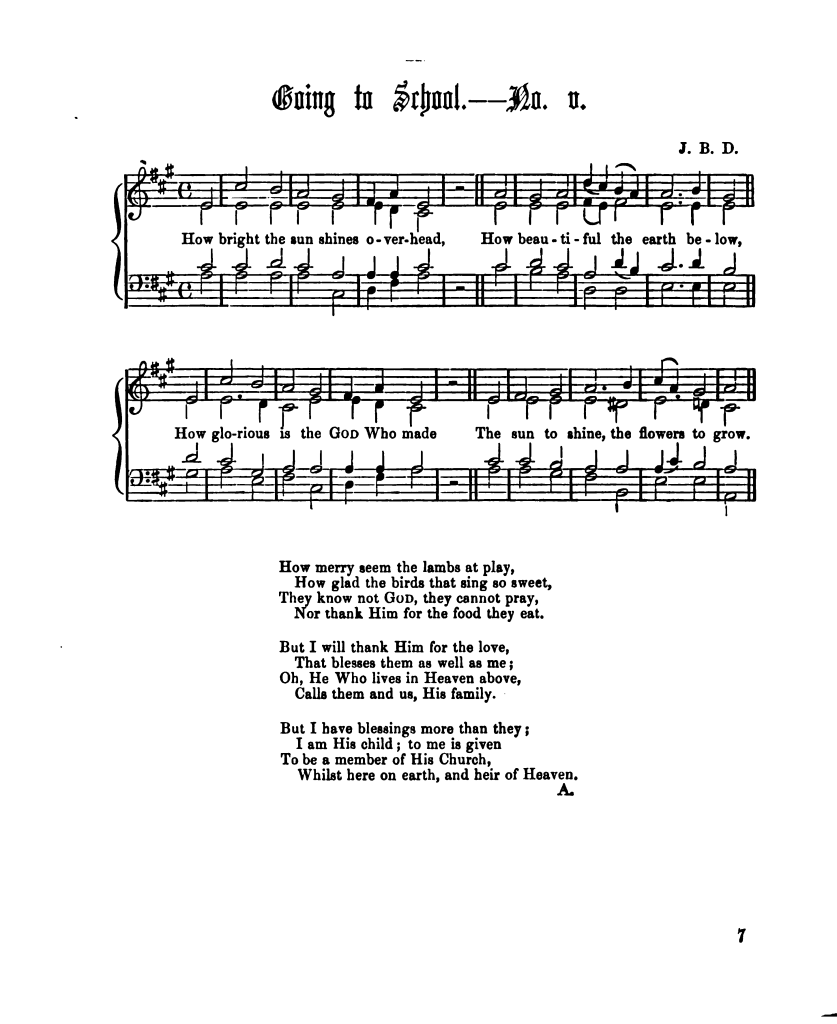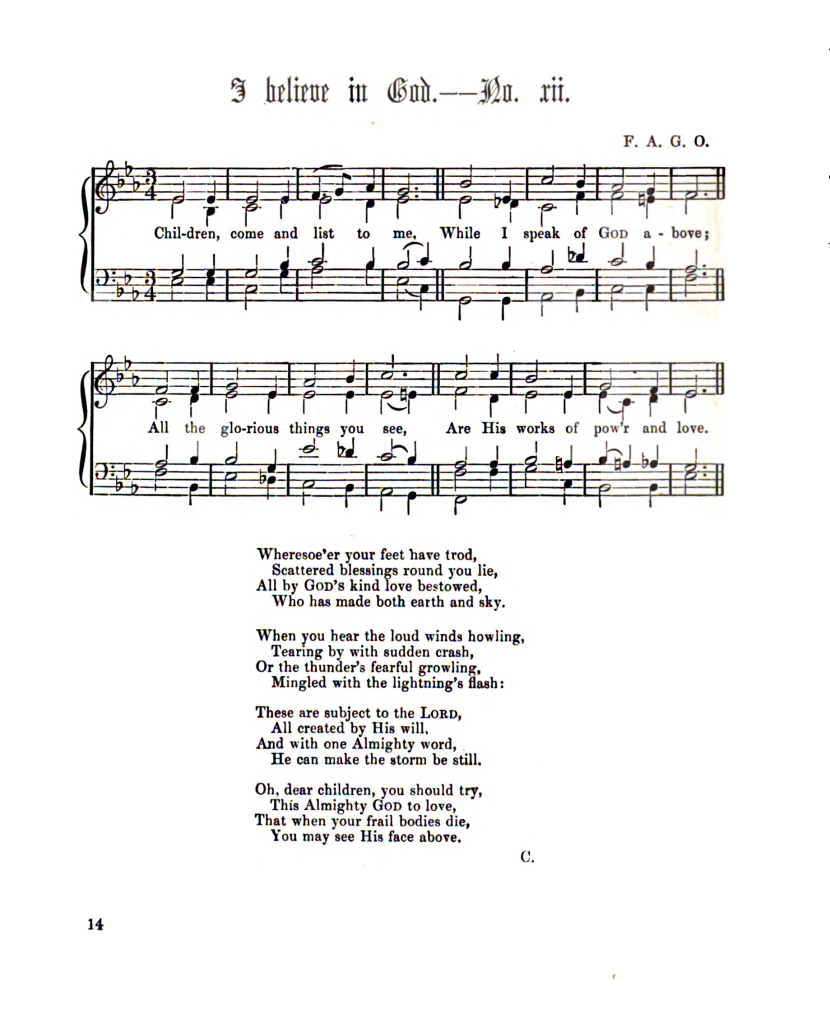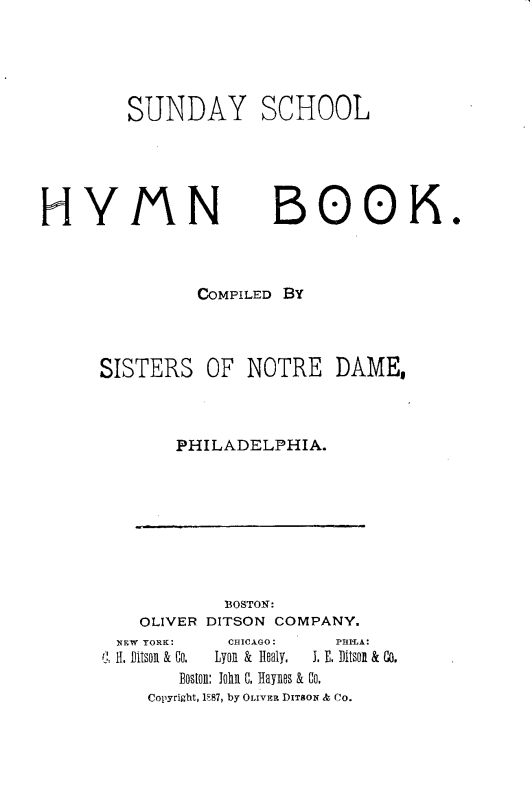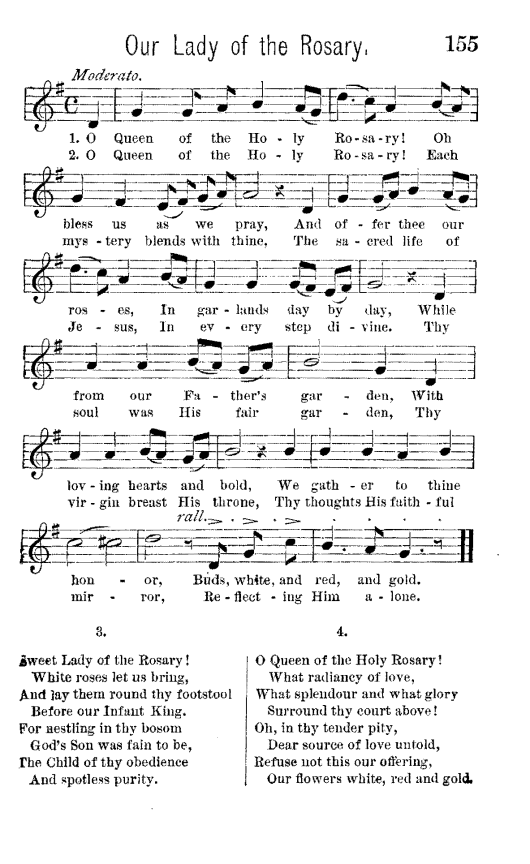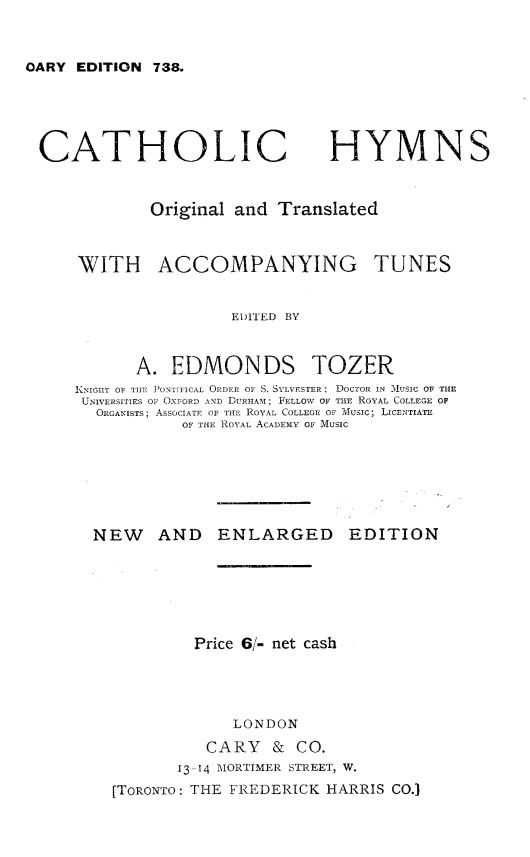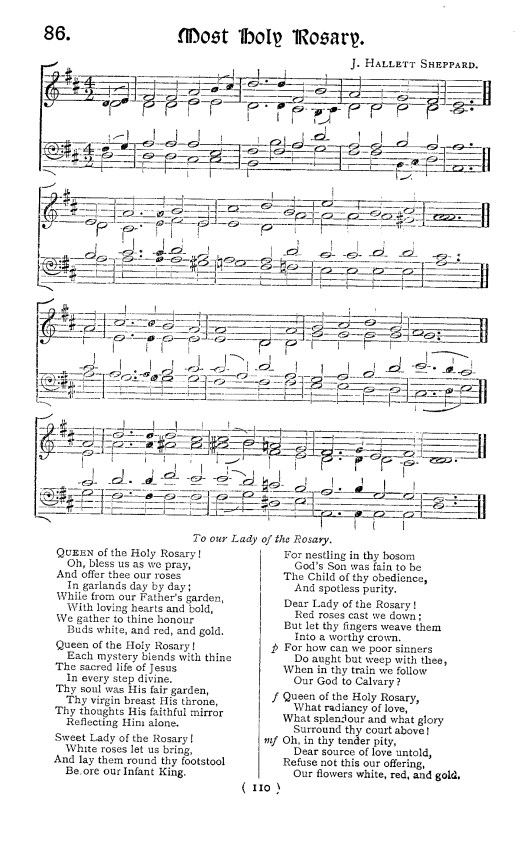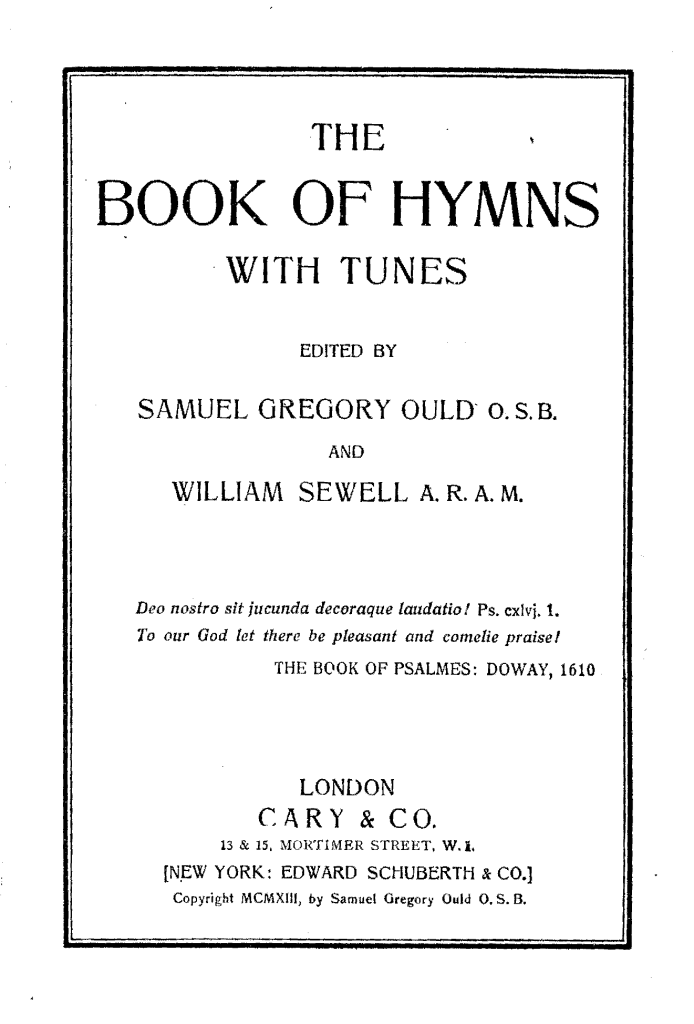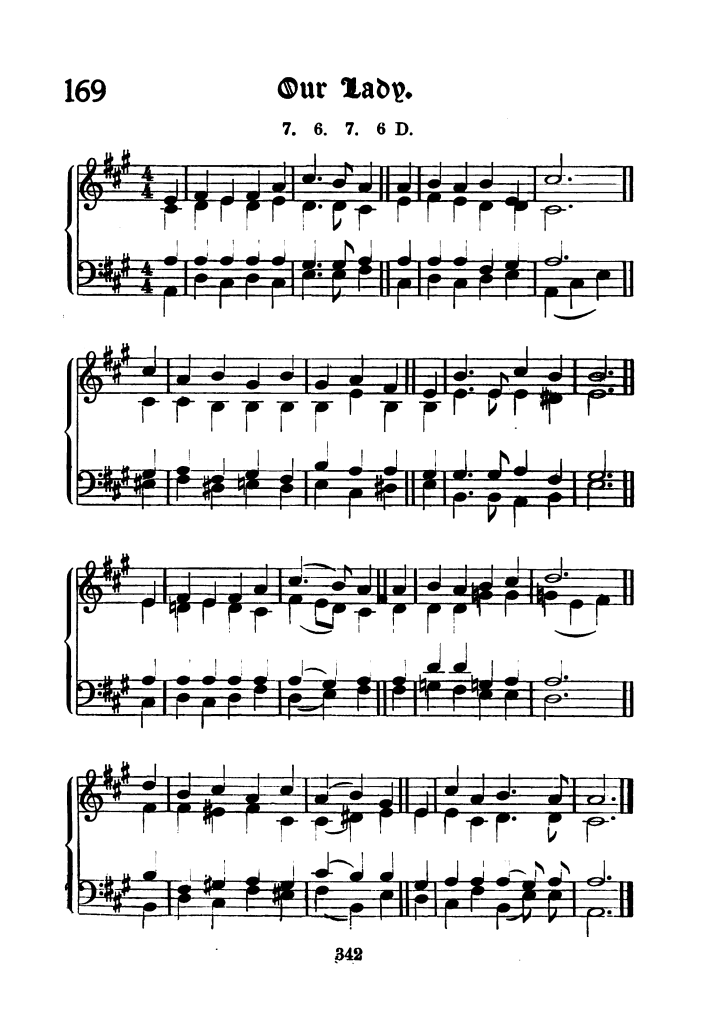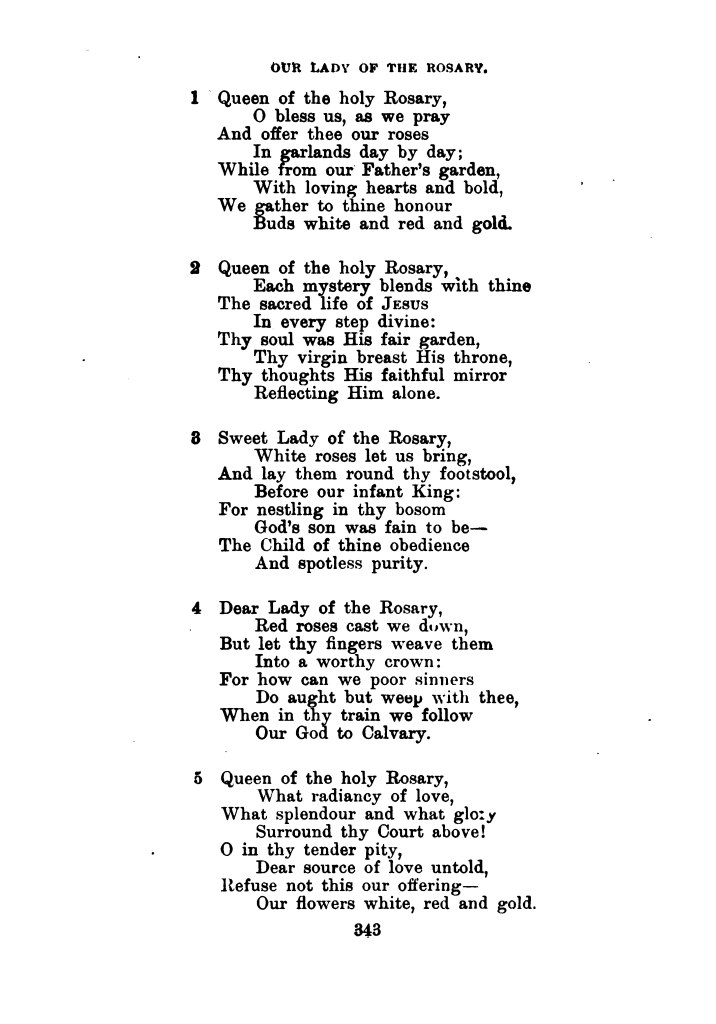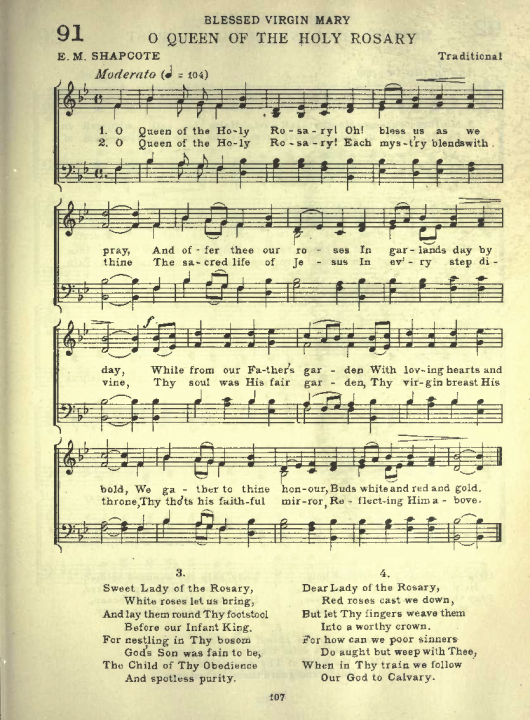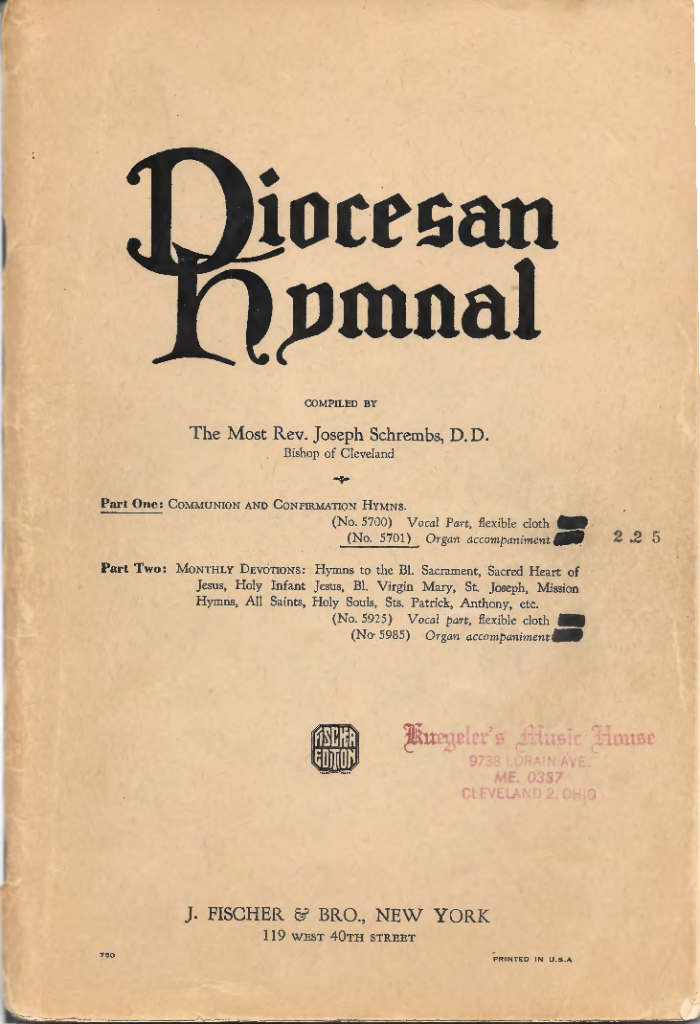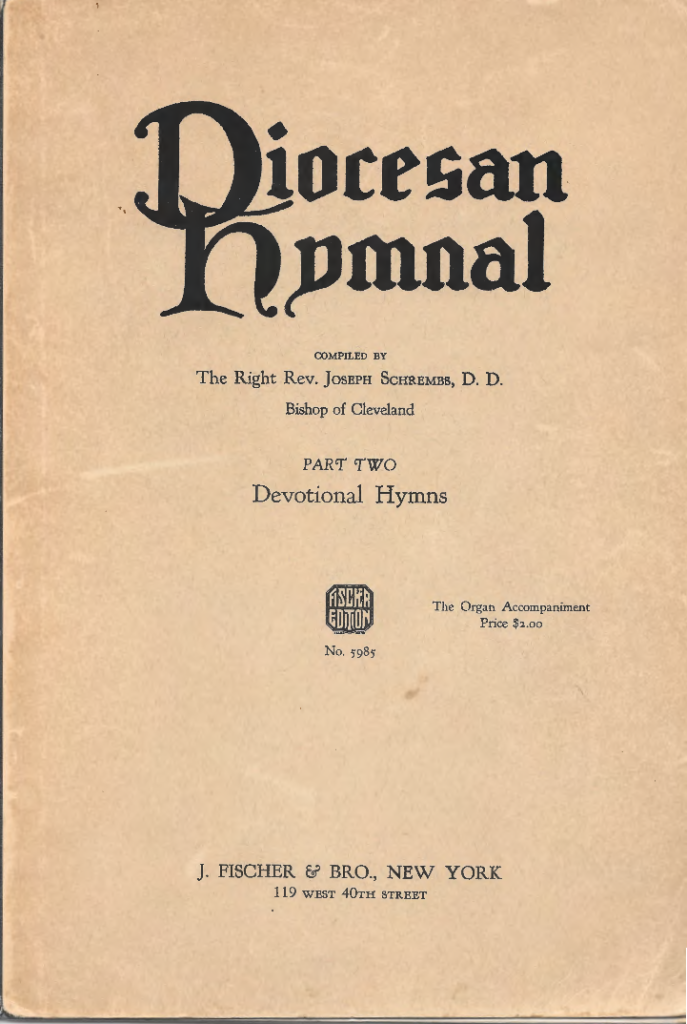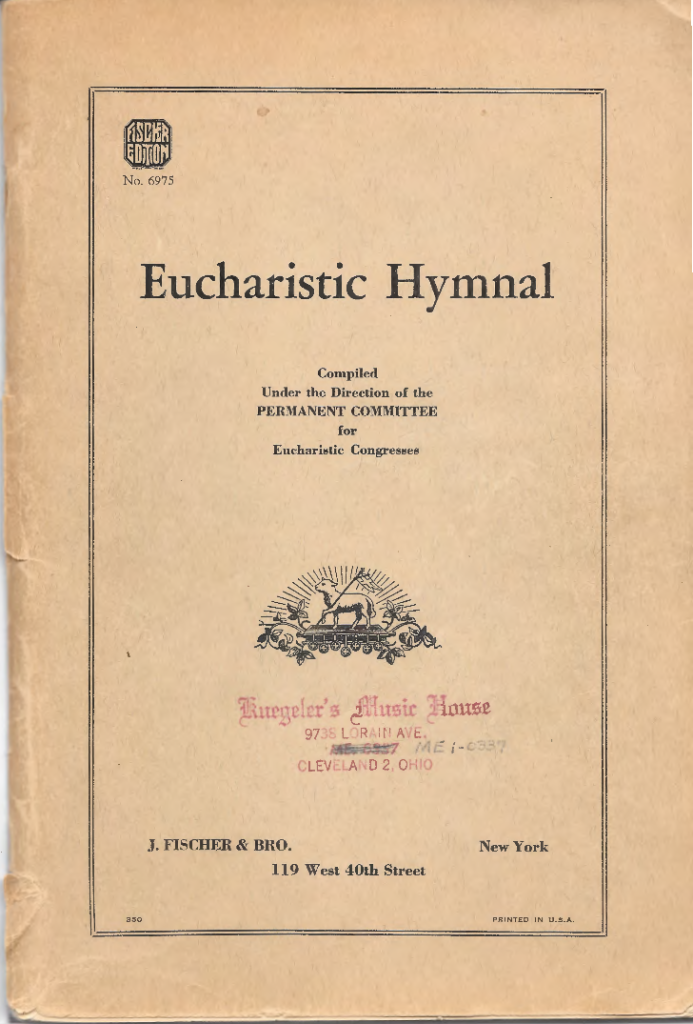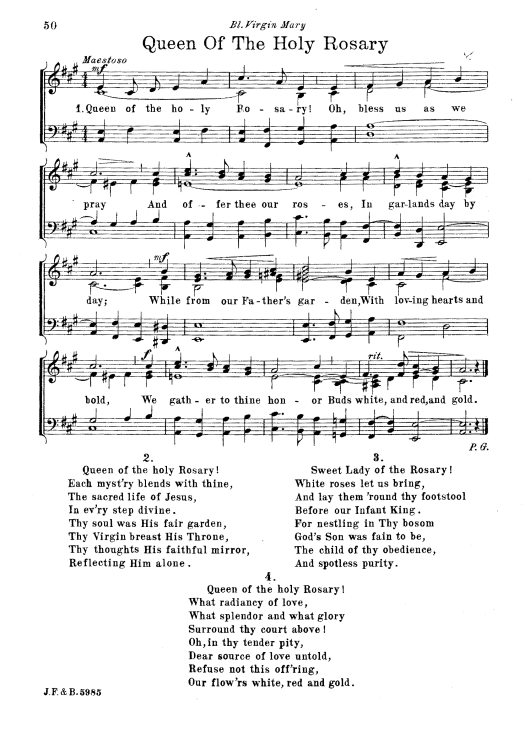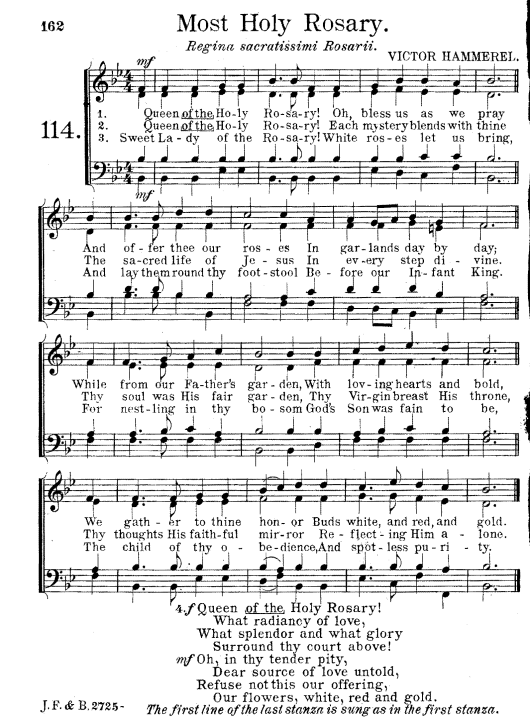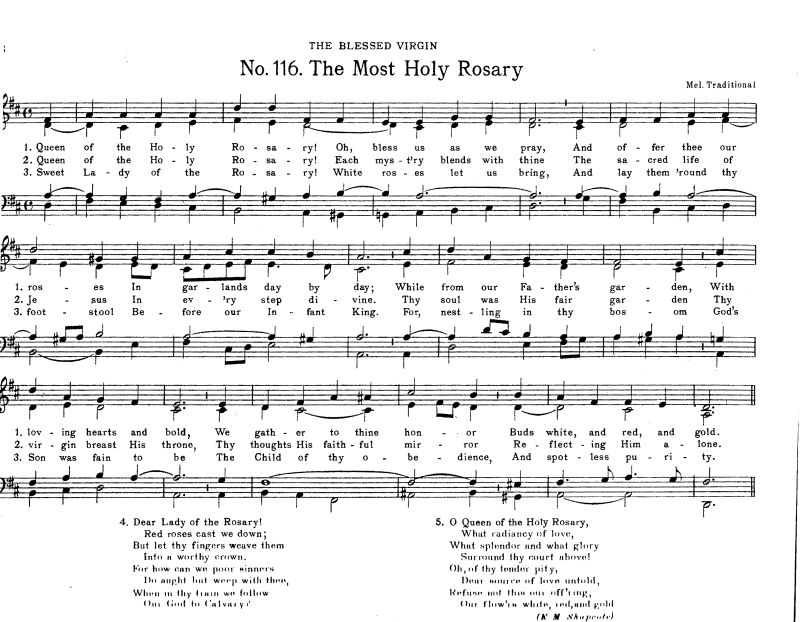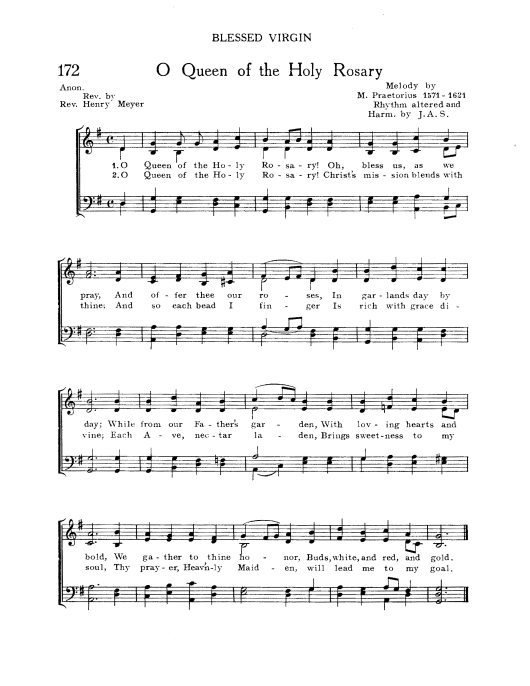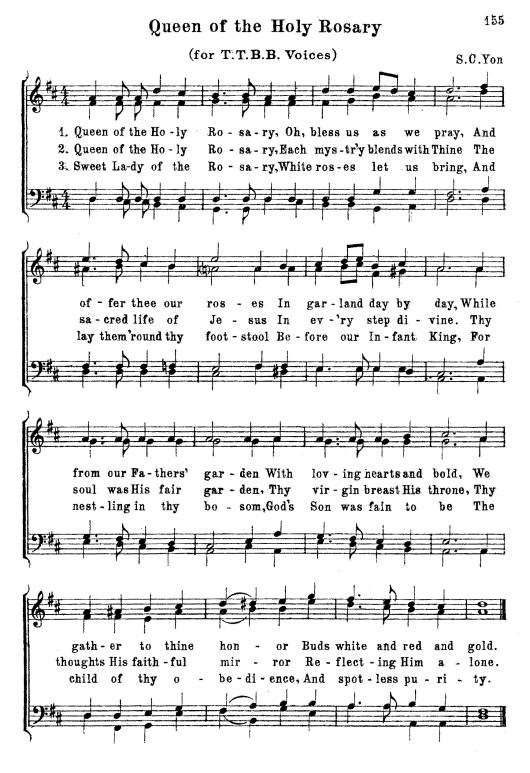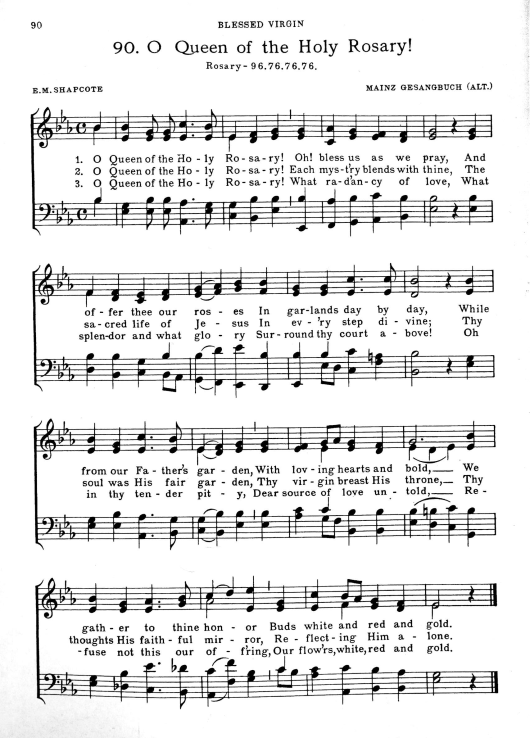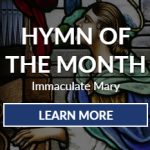Emily Mary Shapcote (née Steward) wrote the words to this hymn in 1882 and it first appeared in ST. DOMINIC’S HYMN-BOOK published in 1885 by Burns and Oates and was sold throughout England and America.
The history books have little to say about Emily, her early life, and her journey to Catholicism. She was born in Liverpool, England in 1828 and married the Rev. Edward Gifford Shapcote in 1856. He was a graduate of Corpus Christi College one of the constituent colleges of Cambridge University and the late curate of St. George’s-in-the-East. He was an English minister in the Church of England and a missionary in Africa. Emily joined the Catholic Church in 1866 and her husband joined a few years later in 1868.
Emily was a hymn writer with several hymns to her credit and is the author of several books including Legends of the Blessed Sacrament published in 1877; Among The Lilies published in 1881, and Mary: The Perfect Woman published in 1904. She co-authored a hymn collection with her sister and aunt – HYMNS FOR INFANT CHILDREN published in 1852 by Joseph Masters of London. Those marked E being by Emily Shapcote, those marked A by her aunt, Mary Steward, and those marked C by her sister, Eleanor Steward. A third edition with accompanying tunes was published in 1872, and was edited by the Rev. John B. Dykes, Vicar of St. Oswald’s in Durham, England.
In 1873, Emily translated the Latin prayer Salve Mundi Salutare (O Saviour of the world, I cry to Thee) A Rhythmical Prayer to the Sacred Members of Jesus Hanging upon the Cross. This prayer is attributed to St. Bernard and is still popular today. A detailed look into the origins of this prayer can be found at the Hymnology Archive.
Emily died in 1909 while residing in the city of Torquay. Torquay is a seaside resort town on the English Channel in Devon, South West England.
In addition to ST. DOMINIC’S HYMN-BOOK above the hymn Queen of the Holy Rosary appeared in the following Catholic hymnals: SUNDAY SCHOOL HYMN BOOK, 1887 thru 1935 compiled by the Sisters of Notre Dame; CATHOLIC HYMNS, 1898 compiled by Augustus Edmonds Tozer (1857-1910); THE BOOK OF HYMNS WITH TUNES, 1913 compiled by Dom Samuel G. Ould, O.S.B., (1864-1939); ST. BASIL’S HYMNAL, 1918 thru 1958 compiled by The Basilian Fathers; DIOCESAN HYMNAL, 1928 compiled by Cleveland, Ohio’s Archbishop Schrembs (1866-1945); CATHOLIC CHURCH HYMNAL, 1905 and 1933 compiled by Augustus Edmonds Tozer; AVE MARIA HYMNAL, 1936 compiled by Father Joseph J. Pierron (1875-1949); the ST. CECILIA HYMNAL, 1928 thru 1960 compiled by J. Alfred Schehl (1882-1959); HOLY NAME HYMNAL, 1947 compiled by Father James J. McLarney, O. P., (ca. 1900s-1969); and MEDIATOR DEI HYMNAL, 1955 compiled by J. Vincent Higginson (1896-1994) ( a.k.a. Cyr de Brant).
The Melodies
The first verse of the hymn began Queen of the Holy Rosary, the O being added to fit some of the melodies. Ten different melodies have been located for this hymn from Catholic hymnals listed above.
One of the first melodies to appear in American Catholic hymnals was composed by a Sister of Notre Dame de Namur from the Philadelphia Community and was published by the Oliver Ditson Company of Boston in 1887. During this time period the Oliver Ditson Company had become one of major music publishing houses and had offices in New York, Chicago, and Philadelphia. The identity of the Sister who composed the melody is unknown. This is not at all uncommon because in those days’ authorship was not given to the individual but to the whole community. This melody continued to appear in later publications of the SUNDAY SCHOOL HYMN BOOK, 1907 and 1935; also the ST. PAUL HYMNAL, 1915; HYMNS USED BY THE PUPILS OF THE SISTERS OF NOTRE DAME, 1921 and 1948; the LAUDATE CHOIR MANUAL, 1942.
A second melody appeared in CATHOLIC HYMNS compiled by Augustus Edmonds Tozer and published in 1898 by Cary & Co., in London and by the Frederick Harris Co., in Toronto, Canada. This collection of hymns is considered to be a musical edition of the ST. DOMINIC’S HYMN-BOOK noted above. Augustus Edmonds Tozer (1857-1910) was a convert to Catholicism and received his Doctorate from Oxford University and was named a Knight of St. Sylvester for his work in the reform movement in England. J. Hallett Sheppard (1835-1879) composed the melody, and little is known about this composer except that he died on January 11th of consumption in 1879 at the age of forty-three. His daughter, Teresa Madeleine Hallett who was only six months of age died a month earlier on December 30th.
A third melody appears in THE BOOK OF HYMNS WITH TUNES compiled by Dom Samuel Gregory Ould, O.S.B., (1864-1939) published in 1913 by Cary & Co., London and by the Edward Schuberth & Co., of New York. This is one of the most important Scottish hymn collections of the early twentieth century. Samuel Gregory Ould is a convert to Catholicism and joined the Church of Rome in 1879. He is best known for his CANTIONES SACRAE: MUSICAL SETTINGS OF THE ROMAN LITURGY published by Novello and Company of London, in 1899. William Sewell (1861-1942) composed the melody. He served as the organist of the Redemptorist Church of St. Mary’s, Clapham for twenty-five years and he composed a Mass setting for St. Philip Neri while he was in charge of music at Birmingham Oratory as well as other Mass settings. He was co-editor of THE BOOK OF HYMNS WITH TUNES in collaboration with Dom Gregory Ould. William was also a convert to Catholicism and joined the Church of Rome in 1885.
The fourth melody which has become traditional to the hymn is from the WIRTEMBERGISCHEN KATHOLISCHEN GESANGBUCH, 1784. The tune name is known as ELLACOMBE. The melody has been used for various hymns and appeared in American hymnals as early as 1872. However, the first American hymnal to use this tune for O Queen of the Holy Rosary was the ST. BASIL’S HYMNAL, 1918. The hymn continued to appear in later editions including the NEW ST. BASIL’S HYMNAL published 1958.
Archbishop Joseph Schrembs, D.D., of Cleveland, Ohio composed the fifth melody, and it was arranged by Msgr. Peter Griesbacher (1864-1933), the melody appeared in the DIOCESAN HYMNAL PART TWO – DEVOTIONAL HYMNS published by J. Fischer & Bro., of New York in 1928. Archbishop Schrembs was the fifth Bishop of Cleveland and served from 1921 to 1945. He was named Archbishop by Pope Pius XII on March 29, 1939. Very few musicians and parishioners remember Archbishop Schrembs important contribution to Catholic hymnody. Below is a brief synopsis of his contributions.
He was a musician and lover of sacred music and composed several hymns. He was instrumental in producing manuals of Gregorian Chant and Catholic editions of music text books for elementary schools. He also envisioned a plan for Church music reform that would begin with young children. He compiled two Diocesan Hymnals and the Eucharistic Hymnal between 1926 and 1935. The hymns embodied in the Eucharistic Hymnal were taken from The Diocesan Hymnal, Books One and Two. Archbishop Schrembs was the Protector of Priests’ Eucharistic League in the United States and Promoter of the Eucharistic Congress in 1935 when the Seventh Eucharistic Congress met in Cleveland.
The Rt. Rev. Msgr. Peter Griesbacher (P.G.) was responsible for a large number of the harmonization’s of the hymns found in the Diocesan Hymnal, Books One and Two. He was a German born music composer and ordained a priest in 1886. He edited a number of publications of Catholic church music and has composed numerous mass settings, a number of cantatas, various choral works, and organ manuals.
Victor Hammerel composed or arranged the sixth melody which is found in the CATHOLIC CHURCH HYMNAL compiled by Augustus Edmonds Tozer and published by J. Fischer & Bro., of New York and The Vincent Music Co., of London. The first printing of this collection was in 1905 and a second printing in 1933. Victor Hammerel was choirmaster for a time at the Church of the Blessed Sacrament and organist at St. John’s Church both within a few miles of each other in Providence, Rhode Island. He composed a number of mass settings, choral works, and hymn collections including HYMNS TO THE SACRED HEART AND HOLY NAME OF JESUS, 1898; DEVOTIONAL HYMNS TO OUR LADY, 1900; TWENTY-TWO CHRISTMAS AND EASTER CAROLS, 1900. This melody also appeared in the PAROCHIAL HYMNAL, 1951 compiled by Father Carlo Rossini for the hymn Queen of the Holy Rosary.
A seventh melody can be found in the AVE MARIA HYMNAL, 1936 compiled by Father Joseph J. Pierron and published by The Bruce Publishing Company with offices in New York, Milwaukee, and Chicago. The melody is attributed to Michael Haydn (1737-1806). The AVE MARIA HYMNAL saw several editions with the first edition published in 1929 and the last edition in 1941. The hymnal is a collection of English and older German melodies. Joseph Pierron was ordained a priest in 1905 and studied music in Europe for three years. He held assistant positions in various parishes and pastorship in several churches throughout the Archdiocese of Milwaukee. In November 1949, he went to Boys Town, Nebraska to serve as music director for Father Flanagan’s Boys’ Home. Father Pierron was editor of the Caecilia magazine in 1930, and composed several hymns, hymn collections, and authored several articles on music.
Hans Newsidler (ca. 1508-1590) composed the eighth melody. This melody is often attributed to Michael Praetorius (1571-1621); however, it is his harmonization of the melody that should be properly credited to him. The melody is identified as Ich Will Ein Neues Singen in editions of the SONGS OF SYON published in London by Schott & Co. This collection of Anglican hymns was compiled by the Rev. George R. Woodward, M.A., (1848-1934) and saw four editions between 1904 and 1923. The melody appeared in the ST. CECILIA HYMNAL compiled by Joseph Alfred Schehl (1882-1959) and published by the Frederick Pustet Co., Inc., with offices in New York and Cincinnati. The hymnal achieved five editions between 1928 and 1960, and was the Official Hymnal for the Schools of the Archdioceses of Cincinatti. Joseph Schehl was a famous composer, choirmaster, and musician from Cincinnati. He dedicated more than sixty years to his musical career and served as organist-choirmaster for forty-seven years at St. Lawrence Parish, Prince Hill, Cincinnati. He composed eight mass settings, various motets, and several volumes of organ music.
Stefano Constantino Yon (1876-1956) composed the ninth melody, and it is found in the HOLY NAME HYMNAL, 1947 compiled by Father James J. McLarney, O. P., and published by McLaughlin & Reilly Co., of Boston. The Holy Name Society consists of thousands of chapters in the United States and remains active in Catholic parishes even today. Constantino Yon or as he was sometimes referred S. Yon, or S. Constantino, was the organist and choirmaster of St. Vincent Ferrer’s Roman Catholic Church in New York, a position he held for almost forty years. He was a composer of hymns and other sacred music, and his choir would perform annually at the Christmas parties given by Cardinal Spellman for the children of New York’s Foundling Hospital. Constantino was a teacher of voice and piano and gave lessons at his home, in his studio in Carnegie Hall as well as the Academy of Mount St. Vincent and Elizabeth Seton School in Yonkers. Pietro A. Yon, the famous organist of St. Patrick’s Cathedral of New York and best known for his choral work Gesù Bambino (When blossoms flowered ‘mid the snows) was Constantino’s younger brother.
The source for the tenth melody may be the MAINZ GESANGBUCH of 1661 or 1870. It is from this collection of German songs that the melodies for To Jesus Christ Our Sovereign King and the Stabat Mater (At the Cross Her Station Keeping) are found. Another source is the CATHOLIC YOUTH’S HYMNAL compiled by Benjamin Hamma (1831-1911) and published by J. Fischer & Bro., of New York in 1891. Benjamin Hamma was a German composer and teacher with a number of hymns, choral pieces, and Mass settings to his credit. This melody is used in other Catholic hymnals for the hymns I’ll Sing a Hymn to Mary and I’ll Sing to Thee, O Mary. An examination of these arrangements did not reveal a composer’s name and it was found that only a few measures from each arrangement appear to be the same, suggesting a common melody which has been altered over time.
Reflection
There are two melodies that I learned while singing in St. Mary’s Choir (1977-2010), the traditional melody (Ellacombe) found in St. BASIL’S HYMNAL, 1918 and the melody found in the SUNDAY SCHOOL HYMN BOOK, 1907 by the Sisters of Notre Dame, captioned Our Lady of the Rosary. In the poetic imagery we can clearly see that our Pater’s and Ave’s recited with each bead we say are likened to roses in garlands, very poetic indeed since the beads of the rosary are strung together like a wreath. The help and grace we receive from praying the rosary are not to be trifled with or scoffed at, for the rosary has brought many souls to Christ.
As I was taught, each decade of the rosary is a journey in the sacred life of Jesus and every bead like a step toward Calvary. In singing this hymn, I have come to believe the author intended the words We gather to thine honor, buds white, and red and gold as symbols of the mysteries themselves. The Joyful mysteries are white roses, and Sorrowful mysteries are red roses, and the Glorious and Luminous mysteries gold roses.
It’s amazing to me that some of our best devotional hymns were written by converts to the Catholic Faith. At St. Mary’s when I sang in the choir, we would sing this hymn before Mass, at Offertory or as a second recessional. The Catholic Church celebrates the feast of Our Lady of the Rosary on October 7, let us sing this hymn once again during the month of October in honor of Our Lady of the Rosary and make it part of our parish repertoire.
A special thank you to Peter Meggison producer of the Devotional Hymns Project for allowing me to link to the choir of Blessed Sacrament Church in Providence, Rhode Island. Five of the melodies listed above are beautifully woven together producing a wonderful and truly uplifting recording.
Also, to Noel Jones, AAGO in granting permission to link to A Catholic Book of Hymns with 295 time-honored traditional Catholic hymns, including two arrangements of O Queen of the Holy Rosary. This is a wonderful collection of hymns with text approved, having the IMPRIMATUR from the Roman Catholic Church in the Diocese of Covington, Kentucky, which make them perfectly suited for Mass and devotions.
Listed below are computer generated sound files. The tempo is approximate but should provide the listener a good sense of what the hymn sounds like. All the hymns are in the public domain. Music directors, organist, and choirmasters, if you use any of these selections in your Sunday or weekly music programs and you make a recording, contact the author and I will feature your recording and choir in the What’s New section of the website.

